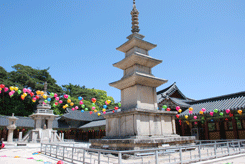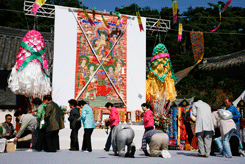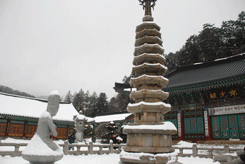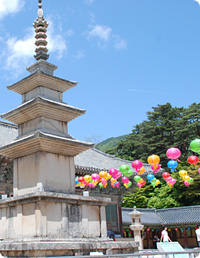Temples
 |
 |
 |
Korean temples have specific standard layouts and buildings are grouped in a typical pattern. To this basic pattern may be added subsidiary complexes, or smaller groupings of buildings called hermitages. Some of the buildings and other structures which may be found in a temple are listed as below.
1. (The One Pillar Gate (Iljumun)
This gate is built at the entrance to the temple ground. Iljumun pillars, usually made of two thick tree trunks mounted on relatively high granite foundations, support a heavy, tile roof. The gate holds a signboard giving the name of the temple.
2. The Four Guardians' Gate (Sachonwangmun)
This is the second gate of the temple. The gate contains four large figures or paintings of the four heavenly kings. They occupy the first of the six heavens in the Realm of Desire, halfway up Mount Sumeru . Known in Sanskrit as lokapalas or world-protectors, they serve Indra as generals and guard the four continents that surround Sumeru. In Buddhism they serve as protectors of the Dharma. Each is seen with his characteristic implement crushing a demon beneath his feet. Dhritarashtra, the guardian of the East - White body, Virudhaka, the guardian of the South- Blue body, Virupaksha, the guardian of the West - Red body and Vaishravana, the guardian of the North - Black body.
3. Non-Duality Gate (Bulimun or Haetalmun)
You had passed through the gates and crossed over the bridge to reach the Buddha's world. But, you still need to dust off the dirt from the mind and clean up and purify yourself once again here at Buleemun before stepping into the Buddha's world. This is the last gate before you get into the Buddha's land. The gate represents yet another teaching that there is only one truth. Bulee is the word for "One, not Two.” For instance, you and I are not two separate being and so are encounter and leaving, life and death, and Buddha and I and so on. Actions in the present state may look different, but they are truly one when you trace them back into their true self.
4. Sakyamun Hall (Daeungjeon)
You first encounter with the main hall after the Buleemun gate or the four guardians' gate. This is the main building in the temple and therefore the building is the largest in size. Daeung is a title of a great hero conferred on the historical Buddha Sakyamuni, to his power of subjugating the four Maras, the demons that hinder cultivation practice. The Buddha, Sakyamuni, is accompanied on right and left sides by other Buddhas, and Bodhisattvas or savior figures, are also enshrined in this hall. Occasionally, a figure other than Sakyamuni Buddha may be reverenced in the main hall, but the principal shrine is not called Daeungjeon. The interior of the main hall is decorated with various Buddhist paintings of Spirit and of main stages of Buddha's life. On the outside, there are paintings, usually on two themes, the life of the Buddha, or the soul in search of true itself, in which the soul is shown as an ox.
5. The Amitabha Halls (Hall of Utmost Bliss, Sukhavati Hall)
The hall is dedicated to the Buddha Amitabha (Infinite Light), or Amitayus (Infinite Life). Known as Bodhisattva Dharmakara before fulfilling forty eight vows and thus establishing his pure land, the Infinite Light symbolizes his infinite wisdom, while the name Infinite Life symbolizes his infinite compassion. Bodhisattva Dharmakara made 48 vows in the Sutra on the Buddha of Infinite Life expressing his desire to establish a Pure Land for all sentient beings. The hall is often built to the west of Daeungjeon. These shrines symbolize Sukhuvati, the idealized world that Pure Land Buddhists believe exists in the Western Quarter. Therefore, the front of the hall dedicated to Sukhavati faces to the east so that worshipers who bow to the statues inside can face west. The Pure Land School teaches that Amitabha. The Buddha of Infinite Life perfected himself in Sukhavati and remains there, preaching for the sake of all sentient beings. Another names are Hall of Utmost Bliss, Sukhavati Hall, and Hall of Infinite (or Immeasurable) Life.
6. The Vairocana Halls (Birojeon, Daejeokgwangjeon)
Certain halls are dedicated to Vairocana, who represents the transcendental aspect of Sakyamuni Buddha as well as all other Buddhas. The flower garland sutra describes Vairocana as the Buddha of the Lotus Treasury World or Flower Store World, which encompasses Samara, the Western Pure Land and all of the other realms. Thus, a Flower Garland School temple normally makes Vairocana the principal Buddha in the main shrine, which sometimes is called the Flower Garland Hall. Another name is the Hall of Great Peace and Light. The original Trikaya enshrined in the Vairocana Hall places Vairocana, who signifies the Lotus Treasury World, in the center and Amitabha and Sakyamuni on each side. However, in Korean temples, Locana Buddha often takes the place of Amitabha. Some of the best examples of shrines dedicated to Vairocana are the Hall of Great Peace and Light at Haeinsa and the Lord of Enlightenment Hall at Hwaeomsa, where certain halls were named after Sakyamuni as the main Buddha.
7. The Bhaisajyaguru Halls (Yaksajeon)
These halls are dedicated to Tahtagata Bhaisajyaguru, the Medicine Buddha, whose domain is the Eastern paradise, or the Pure Land of Lapis Lazuli Light. One of the various epithets for Bhaisajyaguru is the Great King of Healing Buddha, as he vowed to cure all diseases including ignorance, lengthen lives of the sentient beings and eradicate disasters. The Medicine Buddha is associated with the Eastern Quarter and with the full moon, which rises in the east. Another name for his shrine is the Jeweled Hall of the Full Moon.
8. The Hall of 1,000 Buddhas (Cheonbuljeon)
The practice of enshrining a thousand Buddhas in a single hall is based strictly on the Mahayana teachings and the most famous of these halls in Korea is at Daeheungsa. Originally the number 1,000 represents the total of Buddhas who appear during each of the three kalpas (three countless eons), namely the past, present and future. The thousand Buddhas, then, simply mean the Buddhas of the present kalpa of whom Sakyamuni is counted as the fourth. The original and true Buddha manifestation transcends time and is indestructible. A Buddha appears on earth to guide the sentient beings, liberate them from the constant cycle of rebirths, and help them to build up the karma they need to experience the religious rapture. They utilize countless expedient means to lead the sentient beings from the mundane world to the paradise.
9. The Hall of All-pervading Light (Bogwangjeon)
The hall is named in the Flower Garland Stura as the structure in a Magadha, India monastery where Vairocana held the second, seven and eight of his Nine Dharma Assemblies. The Flower Garland Sutra states, 'At this time, the World-honored One was staying at Aranya monastery in a Magadha and achieved 'correct awakening' for the first time. He sat on the Lion's Throne Treasury World in the Hall of All Pervading Light and entered the Samandhi of all Buddhas. In today's temple, the Hall of All-pervading Light is dedicated primarily to Vairocana, the Cosmic Buddha who spreads the light of Dharma Truths in every direction. Other names for this shrine are the Hall of Great Light and the Jeweled Hall of Great Light.
10. The Jeweled Palace of Tranquil Extinction (Jeokmyeolbogung)
It is a reliquary for the Historical Buddha. The structure symbolizes the scene described in the Flower Garland Sutra where Sakyamuni attained the truth of nirvana, under a Boddhi tree to the south of Buddha Gaya, India. The shrine contains the notion that the Buddha enjoys perpetual bliss in the place, so only an altar is inside; no other Buddha images are enshrined here. The actual relics may be inside the altar or in a pagoda just outside. Many temple sites in Korea claims to have actual Buddha relics, but the five most important ones all include the Jeweled Palace of Tranquil Extinction. They are Tongdosa, Woljeongsa, Bongjeongsa hermitage, Beopheungsa, and Jeongamsa. Four of these reliquaries excluding Jeongamsa are said to contain Buddha's relics, (Sarira, remains after cremation) and part of his cranial protuberance brought back from China by Vinaya master Jajang (AD 590-AD 658) of Silla.
11. The Bodhisattva Halls (Bosaljeon)
In Sanskrit, Boddhi means enlightenment and Sattva the sentient and conscious. Bodhisattvas strive to attain the Supreme Enlightenment of the Buddha not only for themselves but also for guiding all sentient beings to enlightenment. The highest stage of bodhisattva cultivation is Ekajati-Pratibaddha, literally bound to one more birth before taking the place of Buddha. This means they have one life remaining in their present capacity to assist the sentient beings. Bodhisattva of such distinction include Avalokitesvara and Mahasthamaprapta, associated with Amitabha; Surayprabha (Bodhisattva of Sunlight) and Candraprabha (Bodhisattva of Moonlight), who appear with Bhaisajyaguru and Meitreya, Sakyamun's attendant. The variety of bodhisattvas stems from the Mahayana tenet that all sentient beings are capable of becoming Buddha.
12. The Avalokitesvara Halls (Gwaneumjeon)
Avalaoketesvara has been translated in Chinese either as the 'one who observe/regards the sounds of the world' or the 'unimpeded observer.' The former title refers to the Bodhisattva of compassion, who responds to all sentient beings who cry for help by reciting her name. The latter appellation suggests a being who contemplates wisely to attain the 'wonderful fruit' of enlightenment and nirvana. Avalokitesvara is positioned on Amitabha's left as his assistant in bringing enlightenment to the sentient beings. She is capable of manifesting various incarnations to save people, and as such is sometimes depicted with 1,000 hands and 1,000 eyes or 11 faces.
13. The Maitreya Halls (Mireukjeon)
Maitreya is considered to be a bodhisattva at present, residing in Tusita and preaching to the Devas there. According to the legend, he vowed to descend to the earth in the distant future (5,670,000,000 years by some accounts), became a Buddha under the dragon flower tree and preached the Dharma to three massive assemblies.
14. The Ksitigarbha Halls (Jijangjeon, Myeonbujeon or Siwangjeon)
These halls are dedicated to Ksitigarbha (Earth Store Bodhisattva) as well as the ten judges of the dead and other denizens of the Buddhist purgatory known as the Department of Darkness. This is where people go after they die to be judged and sentenced prior to their next rebirth. Ksitigarbha was authorized by Sakyamuni to enlighten all sentient beings, delivering them from suffering during the vast period between the Historical Buddha's passing into nirvana and Maitreya's further coming. He vowed to do so, even entering the hell to save the wicked. In Korea, his image features closely cropped hair and no jeweled tiara on his head. His face is rounded and he is often shown holding a pearl in his left hand and the monk's staff with six rings at the top in his right hand.
15. The Manjusri Hall (Munsujeon)
Manjusri is the bodhisattva of Supreme Wisdom. When he is enshrined in his own hall, he is attended by Samntabhdra on his right and Sakyamuni on his left. Sometimes he is depicted mounted on a lion, representing wisdom, power and vigor.
16. Hall of disciples (Nahanjeon)
This is the hall dedicated to the 500 arhats of the historic Buddha. In the center of the altar, sits Sakyamuni Buddha. On the lower level of the altar are small 500 statues of Nahans. Smaller temples have 10 disciples and 16 Nahans in the hall. In addition, there are several other halls dedicated to the Bodhisattavas and Buddhas, and hermitages.
17. The Spirit Mountain Hall (Yeongsanjeon) and the Eight Aspects Hall (Palsangjeon)
Enshrined in this hall is a statue of Sakyamuni Buddha and Palsang-tenghwa (Buddhist painting depicting the eight major events of the life. Yeongsanjeon is contradiction of Yeongsan-hoesang, the scene of Sakykmuni Buddha's preaching. The characters for 'spirit mountain' are short for the Chinese rendering of Vulture Peak, a mountain near Rajagriha, India that is said to have been frequented by Sakyamuni. The spirit mountain hall presents the scene of this sacred ground, and believers worship there as part of the Vulture Peak Assembly, a manifestation in samsara of the transcendental Buddha realm. The statuary in the spirit mountain hall includes Sakyamuni in the center, attended by Dipamkara and Meitreya. On the altar wall hangs the Vulture Peak Assembly Picture, an imaginary scene of the preaching of the Sutra Light.
18. Two story Universal Salvation Hall (Bojeru)
Most large temple complexes include a two-story structure that is positioned between the Non-duality gate and the Dharma halls. Usually the first story serves as the final entrance to the Dharma hall courtyard. The Boje (Universal salvation) refers to the casting of a net across the three realms (Trioka: world of sensuous desire, world of form, and formless world of pure spirit) to rescue humans and Devas.
19. The Big Dipper shrine, Mountain Spirit shrine, Lonely Sage shrine (Samseonggak)
It is usually located behind or left of the Main Hall. The spirit of a mountain is enshrined in the hall. The spirit is shown as an elderly bearded figure seated underneath a pine tree with a tiger behind him. Mountain god paintings are among the typical forms of Korean folk art. Two other gods are Chilseong and Dokseong. Chiisong refers to the 3-star or 7-star deity which rules the Pole Star and is another guise of the Lord of Heaven. Dokseong is a mysterious figure of the Taoism. He is one of the Taoist Immortals who lived on the peaks of lofty mountains. The shrines of the Seven Star Spirit houses the image of the Tathagata of Blazing Perfect Light, a Buddha noted for effulgence with lights streaming from every pore and associated with the Big Dipper. The Mountain Spirit is an indigenous Korean belief of Shamanistic roots, while the Lonely Sage refers to the Honored One Naban, expected to offer happiness to the sentient beings during the age of decadence after the present Dharma has been lost. All Big Dipper Spirit, Mountain Spirit shrine and Lonely Sage have non-Buddhist origins, and their lesser status is indicated by their enshrinement in a Gak in Korean instead of Jeon hall. Sometimes the images all three are placed together in the Three Holies Shrine.
20. The Patriarchs' Shrine (Josadang)
A temple's status is elevated when it is linked with eminent monks, so shrines are erected to house the portraits of great monks who practiced at the temple in the past. Outstanding examples of these structures include the National Preceptors Hall at Songkwnagsa and the Patriarchs' shrine at Buseoksa holding the portrait of Uisang (AD 625 ~ AD 702), who was the founder of Korean Flower Garland School.
21. Belfry (Beomjongru)
It is a two story pavilion where four types of the temple of Dharma instruments are enshrined. They are Dharma drum, the bell, the wooden fish-shaped drum and the cloud-shaped brass. Smaller temples may lack some of the instruments. The bell is struck for the beings under the ground, the wooden fish-shaped drum is played for the beings in the water, the Dharma drum is beaten for the animals, and the cloud-shaped brass is struck for the beings in the sky in a compassionate wish for the beings to awake to the understanding of Dharma during every morning and evening chanting.
22. Lecture Hall (Beopdang)
Beopdang is located behind of the main hall. It is a lecture hall for the monastic establishment or an auditorium. It forms the lower part of the central quadrangle. The hall, in most cases, lacks the statue or image of Buddha or Bodhisattva. Monks and believers usually meet here for the Buddhist teachings or lectures.






